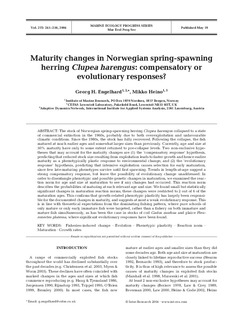| dc.description.abstract | The stock of Norwegian spring-spawning herring Clupea harengus collapsed to a state of commercial extinction in the 1960s, probably due to both overexploitation and unfavourable climatic conditions. Since the 1980s, the stock has fully recovered. Following the collapse, the fish matured at much earlier ages and somewhat larger sizes than previously. Currently, age and size at 50% maturity have only to some extent returned to pre-collapse levels. Two non-exclusive hypotheses that may account for the maturity changes are (1) the Œcompensatory response¹ hypothesis, predicting that reduced stock size resulting from exploitation leads to faster growth and hence earlier maturity as a phenotypically plastic response to environmental change; and (2) the Œevolutionary response¹ hypothesis, predicting that intensive exploitation causes selection for early maturation, since few late-maturing phenotypes survive until first spawning. Trends in length-at-age suggest a strong compensatory response, but leave the possibility of evolutionary change unaddressed. In order to disentangle phenotypic and possible genetic changes in maturation, we examined the reaction norm for age and size at maturation to see if any changes had occurred. This reaction norm describes the probabilities of maturing at each relevant age and size. We found small but statistically significant changes in maturation reaction norms; these changes were restricted to 2 out of 6 of the maturation ages. This confirms that growth-related phenotypic plasticity has largely been responsible for the documented changes in maturity, and suggests at most a weak evolutionary response. This is in line with theoretical expectations from the dominating fishing pattern, where pure schools of only mature or only early immature fish were targeted, rather than a fishery on both immature and mature fish simultaneously, as has been the case in stocks of cod Gadus morhua and plaice Pleuronectes platessa, where significant evolutionary responses have been found. | no_NO |
